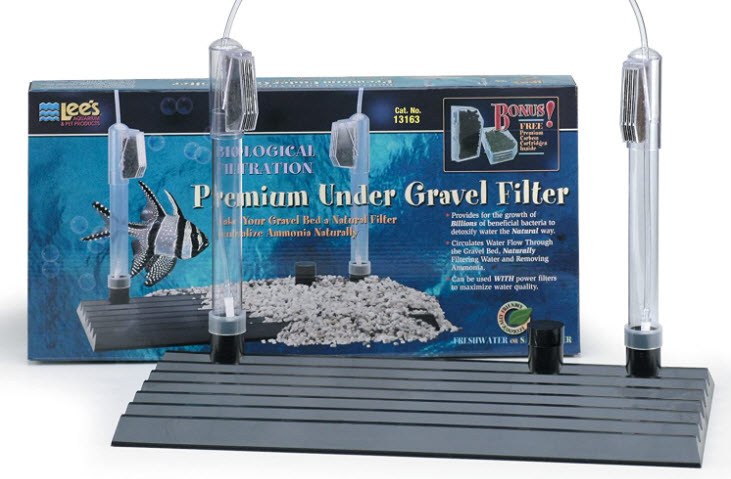
.
A Caveat
Undergravel filters have not been widely tested as a filter in the aquaculture industry, The limited testing done on gravel filters for aquaculture was “all over the map” due to the very high loading of commercial operations. So one is left with common sense and low load testing by the author as the only sources of information in the analysis below.
Another Caveat
Yes, the price of aquarium gravel is very high. But all indications from everyone, including some recent experiences of my own, say that an undergravel filter does best with 3/16ths aquarium gravel. Everything else, including sand, Black Diamond abrasives, oil absorbent, large pea gravel, foam, etc. has large downsides. So I recommend just biting the bullet and buying “natural” cream, tan and dark brown mixed aquarium gravel. It will pay for itself in the long run.
The Myths
Ahhhh yes the myths live on.
Aquarium equipment manufacturers and fish stores who want to sell expensive canister filters (ah, the profit motive at work!) have invented a whole host of negative points about under-gravel filters. None of these points withstands scientific scrutiny. Under gravel filters are still one of the best forms of filtration out there.
Note the brightest, most honest fish keeper in the business, Cory of Aquarium Co-op, recommends under gravel filters. Most shops do not promote them because it is a onetime low profit purchase with no return business. Air operated under gravels have no moving parts that need replacing. I have been using some under-gravel filters for some thirty years and they are still working well. If one can get five years out of most canisters and HOBs, you are doing well. External filters frequently leak but under gravels cannot leak. Canisters frequently spring leaks.
Note that if you clean under gravels frequently, they are a pain in the butt and do not work. If you just leave them alone, they are a great, inexpensive filter with a huge bioload capacity. Put a powerhead on them and they become even better biofilters. “Old technology” like under gravels have only been superseded by our need for shiny new things and expensive “must-haves” that we do not really need. I had them in sixteen tanks and loved them.
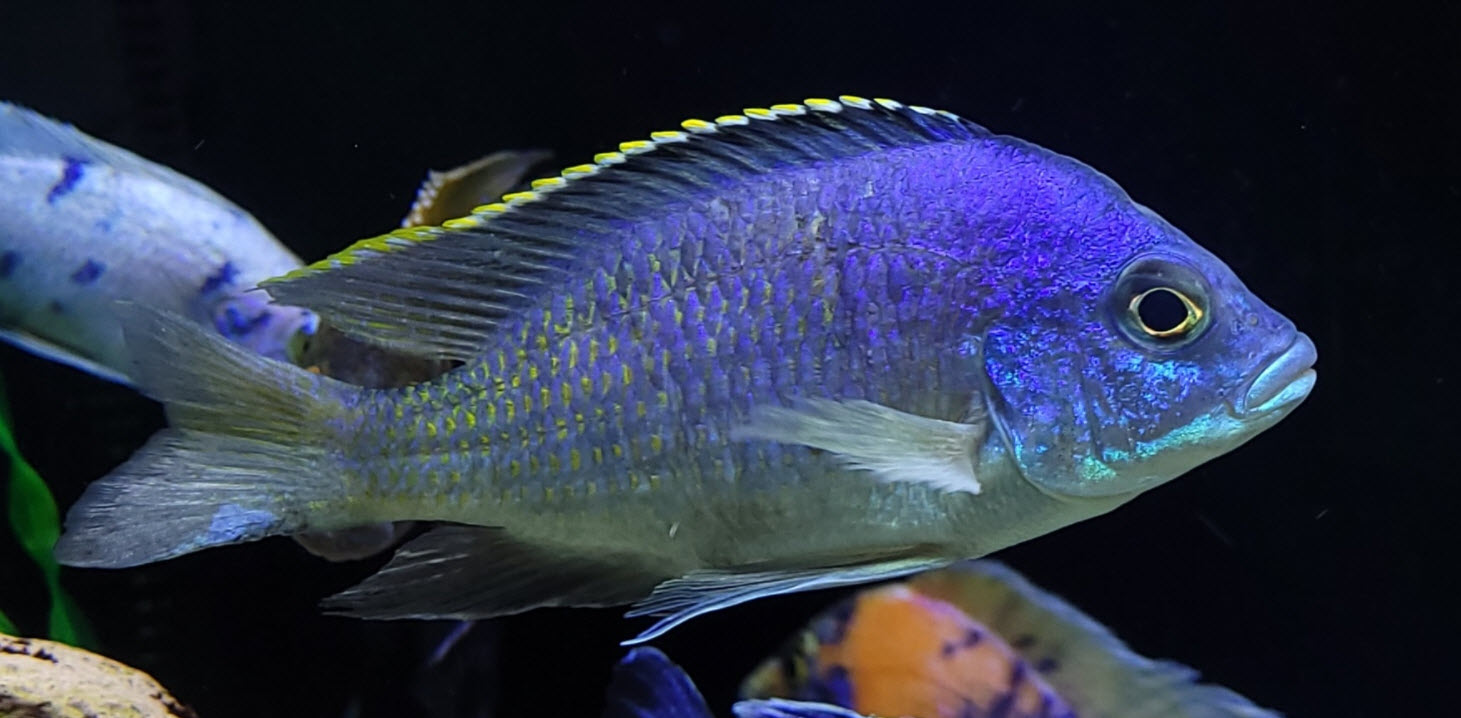
Under-gravel Filters and Biofiltration
Under-gravel filters are great for biofiltration (the media volume is second only to sumps) and crystal-clear water AS LONG AS YOU DON’T CLEAN THEM BUT EVERY FEW YEARS. The brown “gunk” in the gravel isn’t fish feces or “accumulated nitrates”, it is a “brown gunk” (my term for a type of biofilm) filled with beneficial bacteria and many other beneficial organisms which are very good for your aquarium (“beneficial bacteria ain’t pretty”).
From the Poret Foam Supplier (Swiss Tropicals):
“The brown filter sludge in a filter is for the most part alive and not simply waste. Removing this mud does more harm than good. The purpose of the filter media is not to filter out particles from the water as is often assumed. The media serves as the habitat for a vast array of microorganisms that include bacteria, archaea, worms, ciliates, flagellates, and many others. These microorganisms live in a community that is based on biofilms. The biofilms are created by bacteria that secret extracellular polymeric substance (EPS), which is often called “slime”. The community forms a bioreactor that processes the waste and turns it into food and energy for its members, and ultimately into organic or inorganic products that are then used by plants, evaporate, or removed by water changes. It takes a considerable amount of time to establish this “filter community”; consequently, it is very important not to disturb it unless absolutely necessary.”
This is a probably the most intelligent statement any aquarium products distributor has ever made.
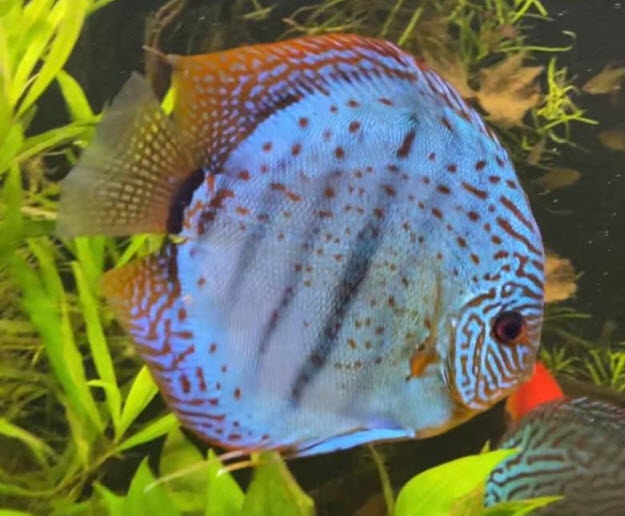
By the verb “clean” above, we mean stirring up the gravel and creating a brown soup which is then removed. We do not mean cleaning under the plates or dismantling the whole thing. There is NEVER a need to do that. The gravel of under-gravel filters will never go hypoxic so bacterial toxins are not a worry if the gravel is stirred.
If under gravels are frequently cleaned (and the term “cleaned” includes “deep vacuuming”) they do not work. But if one uses cheap food that is loaded with fillers one can clog up even an under-gravel. So if your food is under 40% protein, one can vigorously stir up an under gravel once a year or so and then remove 75% to 95% of the brown water. The brown water left behind will reseed the under gravel very rapidly. And the fish won’t be harmed by the brown gunk in the water column.
Now there is a caveat. ANY filter, including an undergravel, can be overloaded. If one over feeds a heavily stocked aquarium with a food that has low protein levels then you can create a cesspool. And NO filter, including an undergravel, will clean up a cesspool.
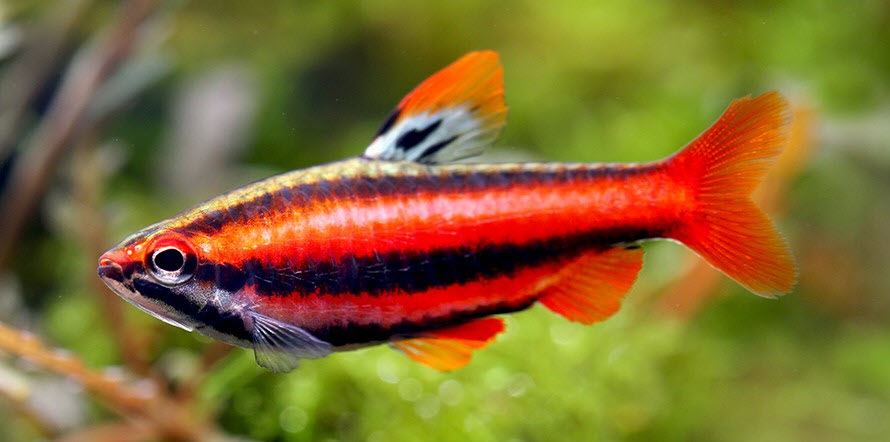
We’ve used under-gravel filters in typically five to fifteen very heavily stocked tanks (which included large digging cichlids) for fifty years. Every two years or so I stir up the gravel and create a brown soup. I then do a 90% water change with frequent stirring of the water to keep everything in suspension.
The under-gravel filters have given us: no ammonia spikes, no build-up under the plates, no “exposed plates”, no “nitrate factory”, no “clogging”, no “disease reservoirs” and no “anaerobic dead areas” (even under décor). And we typically had very heavily stocked cichlid aquariums.
One decided advantage of undergravel filters is that the downward water flow oxidizes and removes feces and mulm above the gravel very rapidly. This makes for a much healthier and much more attractive aquarium. You just will not see feces and mulm floating above the gravel for long if there is an undergravel filter.
And then there is the mechanical problems of hang-on-back and canister filters. We’ve had lots of leaks, seized pumps and noisy pumps with hang-on back and canister filters. Sometimes they have leaked out of the box. And they only last two to five years in my experience. We’ve had several floors damaged by leaks. That is an expensive failure. We’ve had some under-gravel filters for thirty years (maybe even much longer!) with no problems what’s-so-ever and no replacements of anything.
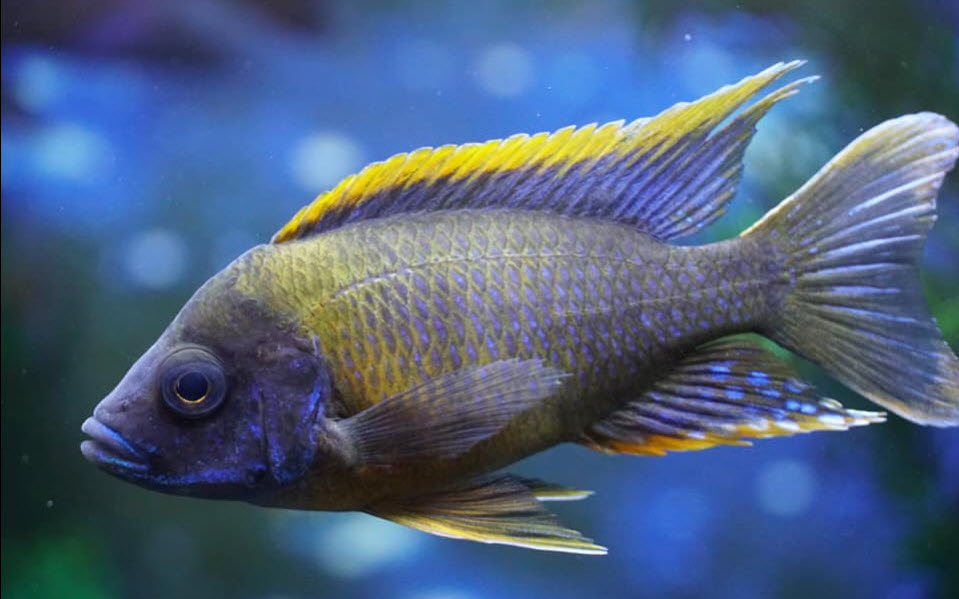
How an Under-gravel Filter Works
Under gravel filters consist of a plastic grate or “filter plate” which lies under small gravel in the aquarium. The thickness of the gravel should be one to two inches, This plate allows water to flow freely under the gravel. Water is lifted up a “lift tube” by a flow of air. This flow then draws water down through the gravel. The gravel then acts as an excellent biological filter.
.
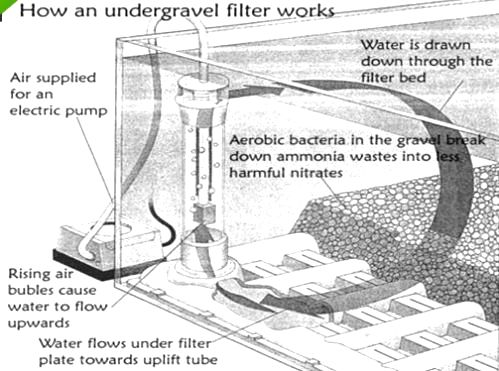
Operation of the undergravel filter
To move the water in an under-gravel filter you use an air pump which moves air into the aquarium through air tubes. This air pump will blow bubbles from an air stone at the bottom of the lift tubes and the bubbles will lift water up the lift tube and into the aquarium. This then draws water down through the gravel.
And the type of air lift used is important. Many under-gravel filters use a simple hole to produce very large bubbles that rise in the air lift tube. The large bubbles are very noisy and throw spray in all directions when they surface. Modify any such filter to use an air stone.
The many small bubbles of an air stone lift much more water than the large bubbles of the hole. So under-gravel filters that use airstones are much better than holed under-gravel filters. The ideal air bubble size is about one tenth of an inch.
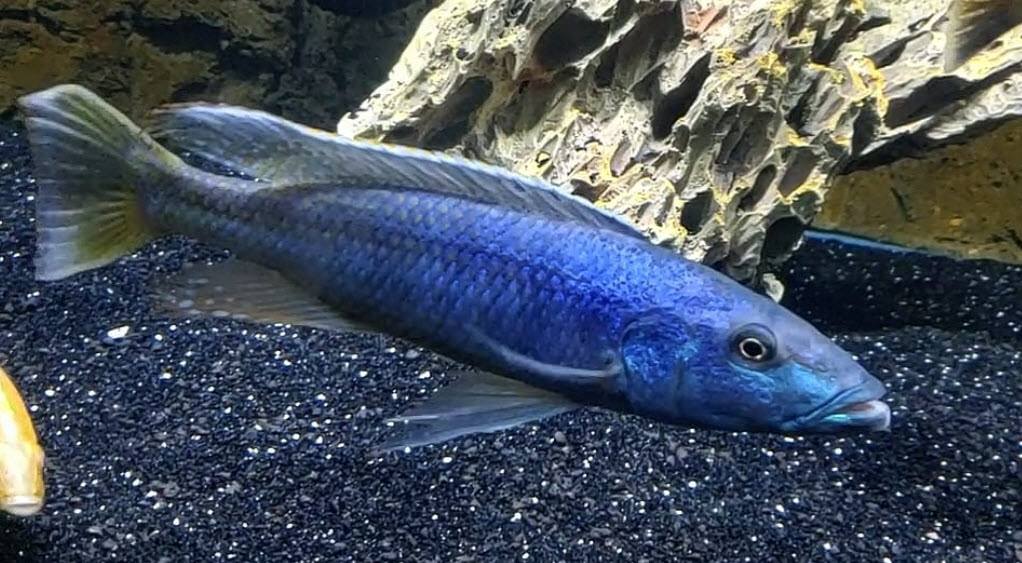
One can alternatively add a pump called a “powerhead” directly to the top of the lift tube. There is no need for an air pump, air stones or air tubes with the powerhead. This makes the cost of the two systems quite similar. I like the powerheads as they are decidedly quieter than air stones and air pumps. Also powerheads move more water than air stones and gives somewhat better biofiltration.
I use small four to five watt powerheads and I aim the duckbill defector at the surface to maximize the “choppy waves”. This “breaking the surface tension” gives very good aeration.
This diagram shows how to use a powerhead with a under gravel filter. If there are two lift tubes use two powerheads.
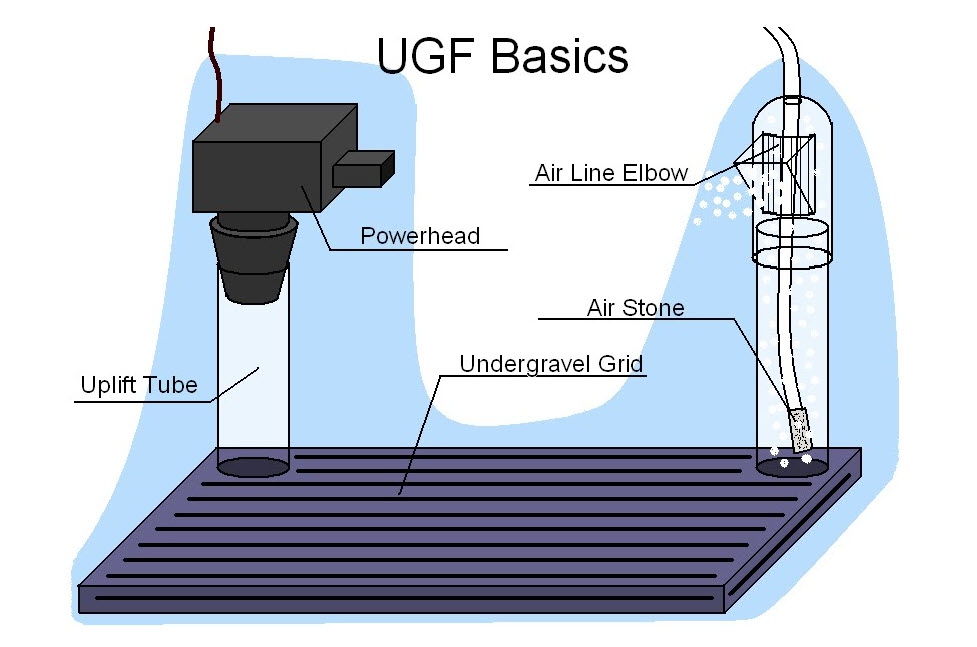
Another idea which came from Cory of Aquarium Co-op is to put the suction end of a canister on the top of the undergravel filter tube. This would seem to be a great idea until you realize a leaking canister will remove ALL the water in the aquarium and kill ALL the fish. Whoops.
In order to use a canister in line with an undergravel filter one must add a hole halfway up the intake tube. This way one can only drain half the water before the siphon is broken. But the size of the hole becomes critical. Too big and you short circuit the undergravel. Too small and you don’t break the siphon. So all-in-all it is an arrangement I don’t recommend.
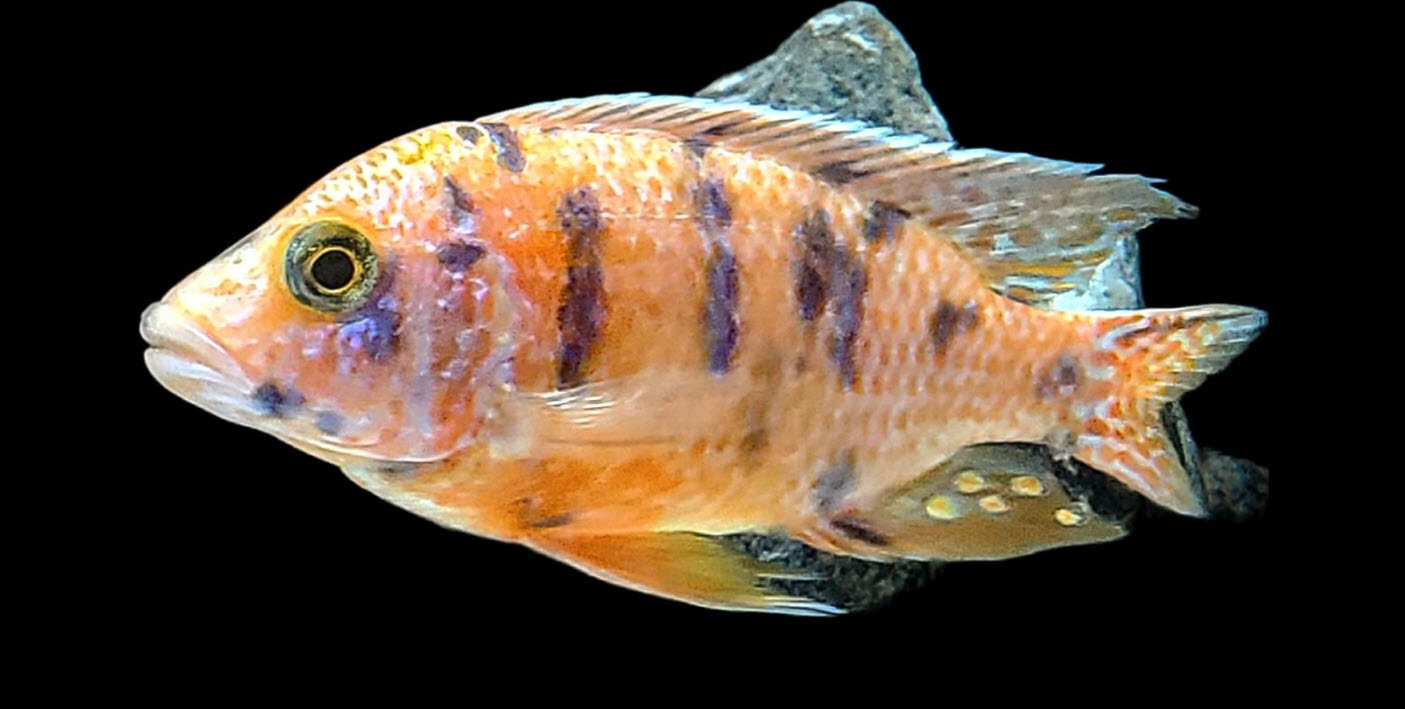
Comparing Under-gravel filters to other filters gives the following:
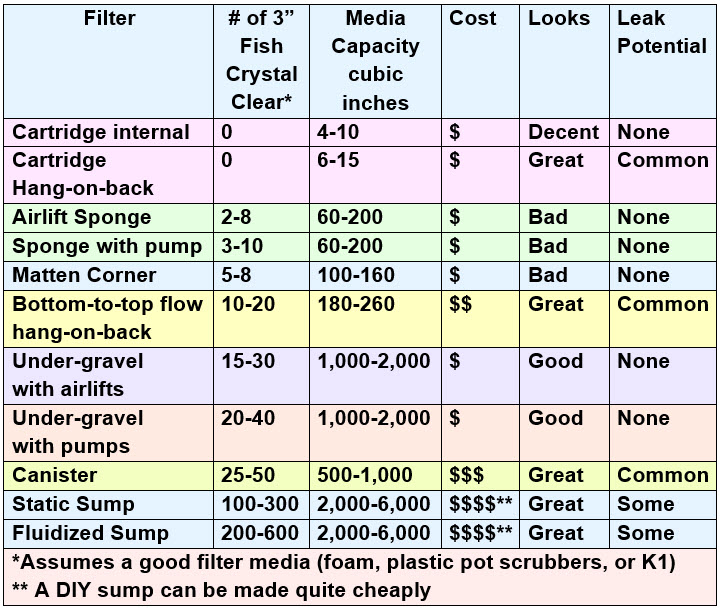
# of 3″ Fish* refers to the number of fish for which this filter can give very clear healthy water. Ammonia oxidation is twenty times easier and these numbers can be multiplied by twenty if the only consideration is ammonia.
Note that under-gravel filters need to be purchased on the internet now-a-days due to the determined efforts of the profit minded filter manufacturers (Petco still stocks them). Also note that it is very feasible to buy an under-gravel filter for say a 30 gallon aquarium and install it on ANY tank larger than 30 gallons.
Note also that for some inexplicable reason the price of aquarium gravel has skyrocketed lately. Some of it is selling for $1 a pound. At three pounds of gravel for every gallon of tank that is $150 worth of gravel for a fifty gallon tank. But note that aquarium gravel is pretty standard as a substrate. Sand is cheaper but has some serious drawbacks.
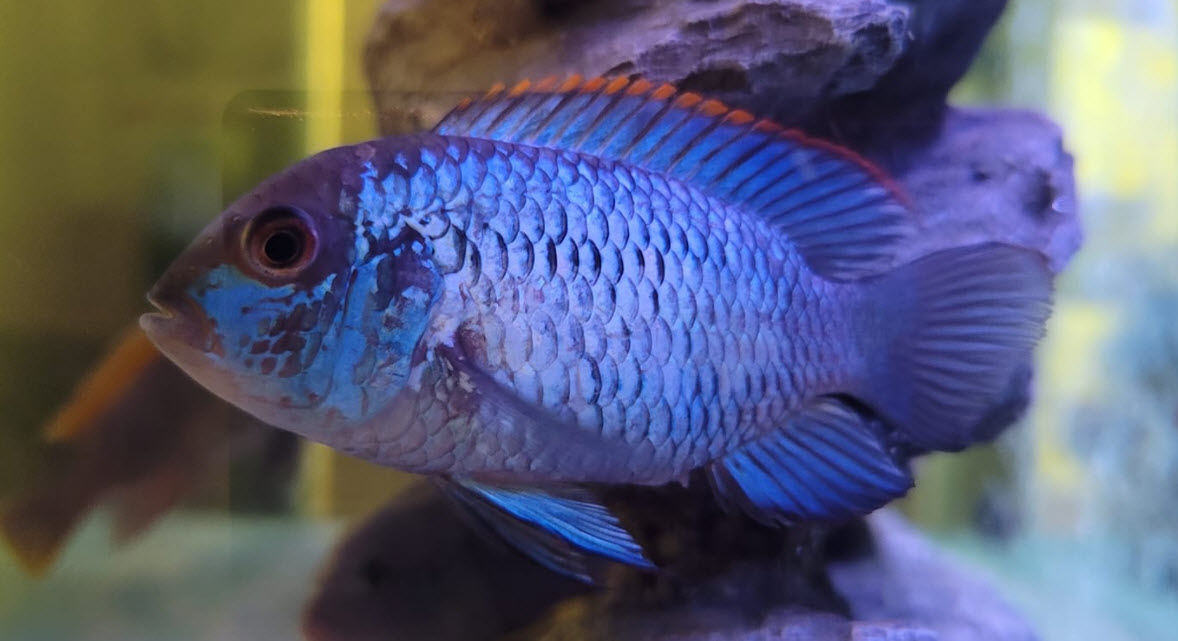
Opposition to Under-gravel Filters
Many well meaning but ill-informed commentators on social media pan under-gravel filters and very few hobbyists use them as a result. The problem is that the panning originated in the marketing departments of manufacturers and suppliers interested in selling expensive canister filters. When local fish stores realized they made more money on expensive canister filters sales then inexpensive under-gravel filters they joined in the chorus. Isn’t the profit motive wonderful?
And then social media got involved. The well meaning but ill-informed commentators on social media did the standard thing of parroting what they had heard from other posts. What the parrots failed to realize is that those posts were put there by canister manufacturers. We have documented this form of social media “influencing” by manufacturers of expensive aquarium goods.
The chief complaint we see about under-gravel filters is that it is “antiquated technology” or “old school”. Since when is something “bad” simply because it has been around for a long time? Is the wheel antiquated?
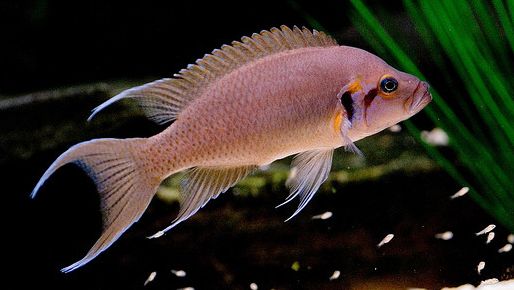
When we have pressed the various well meaning but ill-informed commentators on social media who criticize our use of under-gravel filters on why under-gravel filters are bad, the best they can come up with is that they are “nitrate factories”.
Then we point out that all good filters are nitrate factories. Indeed, the function of all biofiltration is to oxidize ammonia to nitrate and that one gram of ammonia nitrogen is converted to one gram of nitrate nitrogen regardless of where or how it is done (this is a basic law of physics called “conservation of matter”). They then fail to come back 100% of the time. They have no comeback possible.
Another common complaint is that the brown gunk that builds up in the gravel is very bad “dirty” stuff that is very detrimental to the aquarium. This idea that brown gunk is detrimental is the single biggest myth promulgated in the hobby. We go into that in great depth in the undergravel in depth link below (and in many other articles throughout this website). The brown gunk is beneficial bacteria and other organisms which reduce the pollution in the aquarium, not add to it.
Another common complaint is twofold, that under-gravel filters need to be cleaned frequently of brown gunk and that they don’t work. These two complaints are just sadly self-fulfilling prophecy . Under-gravel filters work far better if they aren’t cleaned. So the folks who are cleaning under-gravel filters regularly are only insuring that their under-gravel filters don’t work as well as they should.
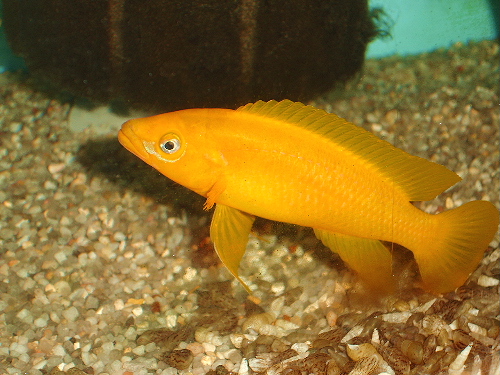
There are some aquarium hobbyists who are interested in delving deep into the science and the calculations behind all aspects of the hobby. For those who are so inclined the following is pertinent:
8.5.1. Under-gravel Filters in Depth
DIY Undergravel Filters
We have designed a DIY undergravel filter for those with a DIY bent. It is not cheap but some want such a design:
8.5.2. DIY Undergravel Filter
Bottom of the Tank Matten Under Gravel Filter
Another interesting type of under gravel filter is placing a piece of charcoal colored foam across the bottom of the aquarium over under gravel filter plates. We discuss this in this article:
8.7.7. Bottom of Tank Matten Filter
.
Return to Filters Menu
.
Aquarium Science Website
The chapters shown below or on the right side in maroon lead to close to 400 articles on all aspects of keeping a freshwater aquarium. These articles have NO links to profit making sites and are thus unbiased in their recommendations, unlike all the for-profit sites you will find with Google. Bookmark and browse!
.

Dave says
In reply to anonymous …… Yes, it is time related. It will probably be one or two months before the undergravel gets to doing its job. Just have patience.
Anonymous says
I’m new to this hobby, and i have a week old aquarium with undergravel filter with canister filter attached to it.
I’m using probably 95% pot scrubbers as a media and 5% polishing filter media. but I’m having a DOC problem, there’s many particles in the water, and plant matter. DOC wasn’t a problem when i my canister filter uses lily pipe as an intake. i don’t know what i did wrong, or things gonna be better overtime.
Dave says
In reply to Frank ….. Your option two is the best balance. And a single powerhead will do it for the UGF.
Frank T says
Oh and related to the below, if doing the UGF in a 36×18 footprint, would one powerhead be enough if I have the two canisters? The UGF dimensions would likely be 33ish x 11
Frank T says
Hello Dave,
I am starting up a 55 gallon tank and I had purchased two canisters that provide lots of biomedia. The canisters were a great price from a major manufacturer and have used them before. But now sitting over a crawlspace with wood flooring, I am a bit concerned by the potential for leaks.
I am considering the following options, trying to balance filtration capacity with leak risk:
1. Dual canisters without a UGF
2. Dual canisters with a UGF, with the canister inflow/outflow removed when away from the house
3. UGF only
In all cases with the canisters, I’d be putting them in the cabinet with a bin and leak detector.
I could always sell the new canisters but was leaning toward option 2 for the over-filtration and mitigated risk.
Thoughts welcome and thanks!
Dave says
In reply to Kayla ….. Gravel only. Forget the aqua soil. And I just buy the cheapest UGF that fits the tank
Kayla says
Hey Dave! Thanks so much for your resource. It’s truly been a lifesaver. I didn’t know how much I didn’t know until I found your site and I’m so grateful you’ve taken the time to compile this information for free.
I want to do a planted tank with an under-gravel filter after hearing your feedback. For this, I was thinking of using gravel topped with aqua soil. What do you think? Or should I do it the other way around—aqua soil then gravel? No aqua soil at all and only gravel?
Also, I know you don’t typically link externally as you don’t have a profit motive, but can you point me to your favorite under-gravel filter readily available on something like Amazon?
Thank you so much in advance! Hope you’re enjoying your holidays!
Dave says
In reply to Shari ……. Do a fifty percent water change when nitrates hit 80 ppm. Note that the nitrate test is often misread. Avoid looking at the darkness of the tube. Instead look only at the color. Orange is 40 ppm while 80 ppm is red orange.
Shari says
Several years ago, I used to have a 29 gallon tank with an UGF and my fish did fine. Unfortunately, I was one of those who cleaned it entirely by breaking it down, including cleaning the gravel each time. I’m surprised none of my fish died which included two angel fish, a betta, a clown loach, and some dwarf frogs, after dumping them back in with less than 50% of their water that I saved each time. About 10 years ago, I got back into the fish hobby again and again, used UGF. I thought the brown sludge was too much to clean so I ended up using hanging filters. It’s been six years since I changed to HOB filters and still struggle with keeping the nitrate down, even with changing my water every week to ten days. After reading this article, it was an eye-opener to realize I didn’t have to remove the brown sludge with my UGF, but to instead, embrace it. I would like to give it another try with my 55 gallon tank that I currently use, but I’m wondering how often would I need to do a water change? I usually change out 25% with my HOB filters (two), so would I need to change out the water just as often? And how much should I remove?
Dave says
In reply to Felipe …… I put together 8.1 before I realized just how good UGF are for mechanical filtration
Felipe bivort haiek says
Hi Dave thank you for the reply.
If UGFs are good mechanical filters why did you award them 0 points in mechanical filtration in the table in section 8.1 ?
Thank you.
Dave says
In reply to Felipe …. Reversing the flow on an undergravel is pretty well a wash. You lose the ability to aerate the water exiting the powerhead. Note any undergravel filter is an excellent mechanical filter and needs no help. And any “push-pull” designs will simply short circuit any undergravel design and render it inoperative.
Felipe says
Hello, do you have any opinions on tunning a powerhead on reverse flow? I have seen it mentioned around the web and it allows for a sponge in the inlet that should help with mechanical filtration.
What about a pull push ( one side of the tank with a reverse flow and the other one with a normal flow) configuration to generate a slow current below the substrate?
Thank you.
Kathie Perron says
I used an UGF many years with crystal clear water. Loved it.
Now….my 1 year old 20 gal planted aquarium has been cloudy for the last month or so. The uptake tubes get coated and look like they are bringing up the brown gunk from underneath the UGF. (My previous aquarium never did that.)
The airflow is very good and the gravel is very clean. I do a 20% water change every 2 weeks.
Could my airstones be either too far down in the tubes….or not far enough?
Any ideas?
Thanks.
Dave says
In reply to Kieran …..
1, I don’t think you like the “engineered rough tile” look you’ll get with a gravel slate mix
2, Crushed slate is just a form of crushed gravel and will work just fine for an UGF
3, Flow is no where near as important as myth would suggest. 1-2x the volume is fine, including for UGFs
Kieran Lee says
Hiya from downunder
Love your resource. It has become a life saver to me to cut through the bullshit. I’m trying to transition toward undergravel filters because I like the simplicity and the silence. Unfortunately I really don’t like the look of gravel. I am trying to think of options and I am looking at the matten type modification you mentioned and/or sponge down the track. But I have 2 questions for now
1. Could I put down a bed of gravel as per your instructions and cover it at the front top and sides with a layer of slate crushed to a smaller gravel type size 5-10mm or use the 4-5cm chips I have without crushing them?
2. Can I use slate crushed to gravel size alone on top of the undergravel filter? Or is it too smooth for biomedia.
3. I notice you mentioned using 4-5 watt powerheads. I have easy access to those Kmart filters and they attach very nicely to the uplift tubes but they are only 200L/hour about 2.5 watt. Would they be suitable or would you recommend having 2 of these pumps instead of the one 4-5watt powerhead you recommend using? Do you have a litre per hour recommendation for the powerheads, it seems 4-5x the tank volume might be unnecessary for an ugf from reading your site.
Many thanks in advance.
Kieran
Yan says
Thanks Dave, I think unless there’s mulm corys will be ok.
Dave says
Yan …. The detritus in an undergravel filter won’t affect the barbels of corydoras. I’ve had probably hundreds of corydoras over the years with UGFs and never had any problems.
Dave says
In reply to Cody… Fluval stratum substrate will not plug up an undergravel filter. But note that the product is a scam and doesn’t help plants at all.
Cody says
The Fluval stratum is a volcanic soil that is in a gravel like form and its to help plants grow and have more nutrients than just gravel. I don’t want to clog up the UGF if I use it so if it’s going to do that I can just stick to my gravel.
Cody says
Thanks Dave. Now as far as substrate goes I use gravel but was thinking of adding some Fluval stratum substrate under the gravel for my plants. Will that work with an UGF or will that clog it up?
Dave says
In reply to Cody ….. ALL powerheads are made in China and are equally unreliable. I simply buy the cheapest ones available on Amazon. Usually they fit a one inch lift tube quite well but adding some meat to the powerhead with some duct tape is also quite easy.
Cody says
For an undergravel filter, what powerhead do you recommend? Ive never used them before so I know nothing about what would be a reliable one. I’ve seen that Fluval has some, aquaclear has some, marine land and topfin, as well as names I don’t recognize. I was looking at a pennplax UGF on Amazon and it has a 1inch diameter lift tube and I want to make sure a powerhead would fit properly. Thanks for your help
Yan says
I was ready on the web site of a fish seller that UGF are not recommended for Corydoras. They say that they can lose their barbels if kept in poor conditions (dirty substrate).
What’s your experience with those fish.
Dave says
In reply to SY …… Part of the sump set-up is balancing the flows so everything works correctly. This is difficult to do with an undergravel as part of the equation. So all my setups which had both had the undergravels on separate loops
SY says
Thank you for this excellent evidence based blog, it has been a real help! I enjoyed the nerdy parts.
May I ask, would it be possible/helpful to connect an undergravel filter to a sump filter (as in, in series with the lift tube from the undergravel plate connected to the sump K1 reservoir?)
Dave says
In reply to Steve ….. Just maximize it. There is no magic number.
Steve says
what percentage of the tank bottom must be covered by the filter plates?
Dave says
In reply to Kyle …..I just use the smallest powerheads I can buy as one doesn’t need a lot of flow with an undergravel filter. Output low in the tank if you wanted planted (and yes, few fish). As for the gravel I would bite the bullet and get the expensive 3 to 6 mm aquarium gravel from the store. It is just the best stuff for an undergravel filter.
Note that you are describing a high tech planted tank with low fish loading. A small canister might well be a better choice than an undergravel, given the price of the gravel.
Dave says
Basalt gravel will work just fine
Lalio says
hi dave can i use basalt gravel on aquael separating the coarse fraction above 3mm for Undergravel filters. It is not mentioned anywhere about basalt as a media
Kyle M says
Dave, I’ve really enjoyed your website and now I’m sold on trying a UGF for my first tank setup in 30 years. Thanks for the info you’ve already posted! Even after reading the comments, I have several questions.
I have a tall 56-gallon tank with an oddball 30×18 footprint. I was able to find several kits with the same modular, 7.5×14.5cm grid-plate design that slots together and gives reasonably complete coverage. It seems best to use both lift tubes that came with my plates, and small powerheads on each of them. Is there a “gph” rating that would be best to keep under? Something like a combined 3x to 5x the tank volume in rated turnover, or whatever? I don’t need to recreate a hillstream level of current inside the tank (saving that for my patio pond). But I would rather go with pumps than air stones.
I’d also like to keep some plants that don’t have “Java” in the name, would it make sense to keep the powerheads’ output lower in the water column to minimize surface agitation and CO2 off-gassing? (I assume that would also necessitate relatively light fish stocking levels.)
Bagged aquarium gravel is basically highway robbery these days. I’ve been checking local landscaping suppliers for a crushed stone product that’s aquarium-gravel sized and keep striking out. You mention “sand” being an issue with UGFs on this page but don’t really elaborate on that. Could I use medium (12-40) Black Diamond blasting grit as the substrate over them? I already have some washed, since this was going to be a Walstad-type dirted tank originally. I also have pool filter sand, which I understand is more tightly screened to keep clogging fines out and ensure good flow.
I tested some BD with my UGF grill plates and it seems I’d at least need to use some weed barrier fabric to keep it from passing right through. A gentle sift let every single grain fall through the plates.
I’d really appreciate any light you could shed on these questions, even if it’s to tell me I’m going about this all wrong.
Ian says
Dear Dave,
Thanks for the great website!! I’ve got a background in microbiology, and between your info and father fish, I became quite enamoured with the idea of running a dirted tank with a living ecosystem containing as complete a food chain as one can maintain in a small tank full of ravenous predators. In order to get the bacteria as diverse as possible, I decided to go with 75% enriched substrate + sandcap, 25% UGF. Normally everybody says you cant have a UGF in a dirted tank, but I simply put it in a plastic tray and buried it carefully such that sand cant get into it in any significant amount.
Got to say, my tank water was extremely clear after only three days, despite having a significant bacterial bloom before that. I’ve got ten little zebra danios and ten chilli rasbora, and they are all doing quite fine by the looks of it. We are looking to add a few denizens (shrimp and a bristlenose) soon, now that some algae is starting to show and going after your “if the water clears, the filter is ready for more fish” metric. I’ll just make sure to deworm for planaria before hand (and will have to carefully culture and add detritus and blackworms later).
Dave says
You have several options. For small aquariums like a 20 gallon I like the Sunsun HW-603B External Canister Filter ($40). It has 80 cubic inches foam which makes a great biological filter if you only very lightly clean it once every four to eight months (ignore the profit minded directions which say to replace the foam). Also I like under gravel filters ($20). If you clean under-gravel frequently, they are a pain in the butt and do not work well. If you just leave them alone, they are a great inexpensive filter. Matten filters are also good inexpensive options as are good old sponge filters. Personally I would go ahead and add a powerhead operated undergravel but that’s just what I do.
Tiffany Duffy says
I have a HOB filter now, was about to get a sponge filter. I had an under gravel years ago before I gave up the hobby for motherhood. I now have a 30 gallon, and want to go back to the UG filter. Is the hassle of uprooting the tank worth it, or just go with the sponge?
Dave says
In reply to Amit …..Yes they will expose the plates on an undergravel. It turns into a game. They expose the plates, you cover them back up. I used to play it on a daily basis with my mbuna. It doesn’t seem to affect the operation of the filter at all. So do not worry about it.
Amit says
Hello Sir, The Mbuna I got they are moving the gravel and I have undergravel filter. I know you have told not to get crushed coral but this is only what I could find with the Guy I dealt for all other things. What shall I do? They haven’t reached the bottom as I have about 1.5 inch gravel from the front going up to 03 inches to the back. Will they dig it up fully or if they do will it affect my Aquarium? They remain in one corner of the tank and are very skittish, just got them a week ago. Thank you.
Dave says
In reply to Brandon …. Your concerns are well founded. Aquasoils break down into a clay like sediment which will clog the UGF plates. And the water flow through the aquasoil will put all the nutrients into the water column very rapidly. I wouldn’t recommend aquasoil with an UGF.
Brandon says
I really appreciate all this info! I am thinking about getting back into the hobby and always loved my UGFs. Really enjoying the aguascaping movement and excited to set up a zero maintenance aquarium in the 20-30 gal range. Has anyone used aqua soil in bags above a UGF w/ powerhead? My plan is to install the grates, add a 2″ (thicker?) layer of gravel, put 2-4 mesh bags with aqua soil on the gravel (to build up hills on each end of the tank) and then cover the aqua soil bags with gravel. The thought being the aqua soil will help the plants get started while I increase the number of fish over time. My concern is mainly that the agua soil will come out of the bag and migrate into the filter grates causing the system to clog.
Dave says
In reply to Shana … ANY filter, including an undergravel, can be overloaded. You are overloading an undergravel and will need to clean it frequently.
Shana says
Hi Dave I have undergravel filter in my tank. I have two giant turtles with two tin foil barbs that are just as large as the turtles. I know that the no. 1 rule of UG filters is you don’t clean them but I feel that this is based on fish-only tanks. I wonder if it’s applied to heavy-load tanks as well? I clean the gravel once a month because if I don’t, the brown gunk piles up and covers the entire substrate to the point that it’s no longer visible. It took several months by the way.